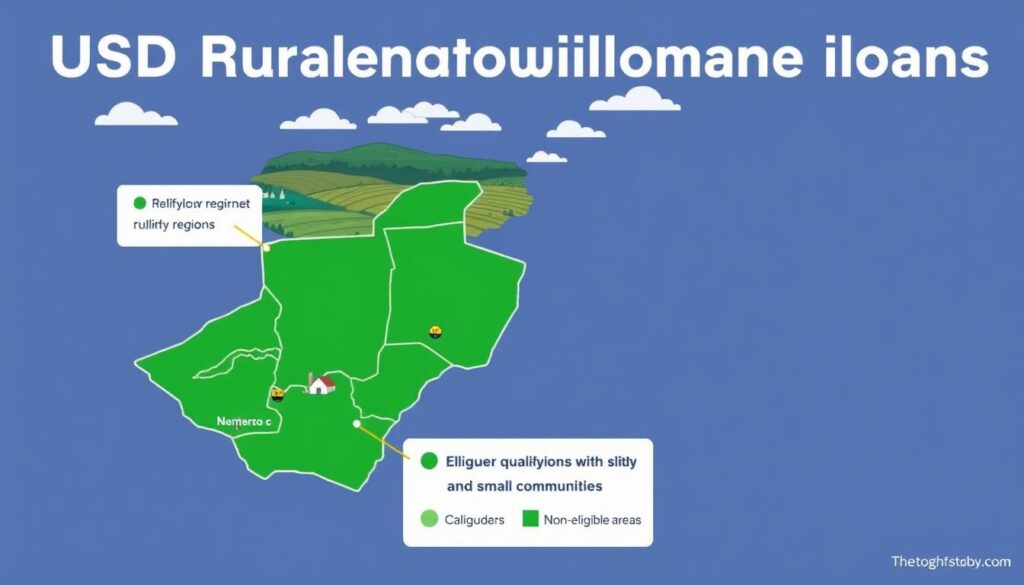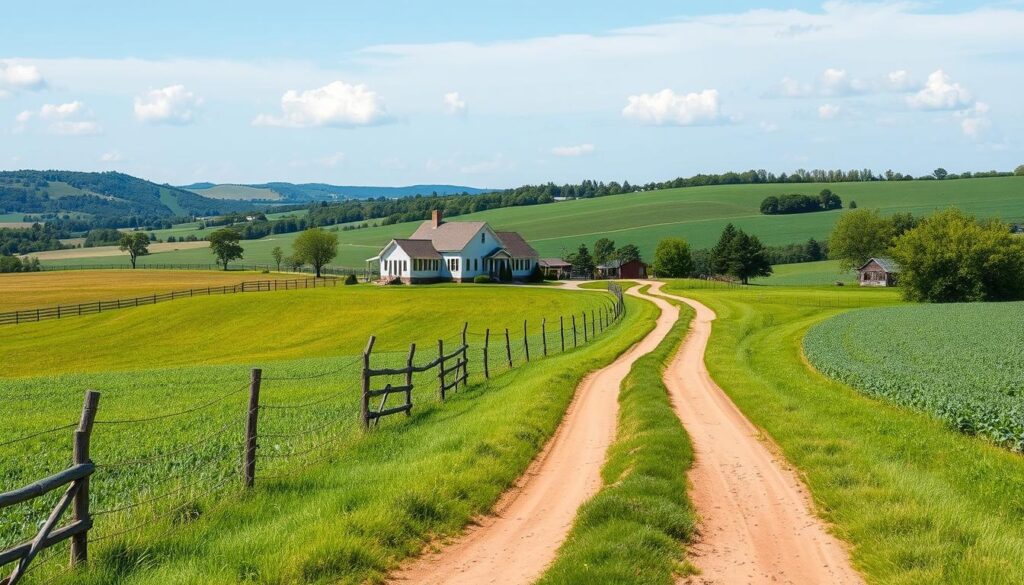Amidst the challenges of attaining homeownership, USDA loans emerge as a beacon of hope for individuals seeking a life in the pastoral settings of rural America. As advocates for economic vitality and improvement of living standards in less urbanized regions, we recognize the significance of these government-backed home loans. USDA loans not only exemplify a bridge to acquiring a home with zero down payment but also signal our commitment to fostering vibrant, prosperous rural communities.
Heralding from pivotal housing acts focused on revamping rural living conditions, USDA loans today persist in propelling lower to moderate-income families toward the dream of homeownership. With varied options such as USDA guaranteed loans, direct loans, and home improvement loans, these programs are custom-designed to meet the financial exigencies of prospective rural homebuyers.
Key Takeaways
- USDA rural home loans enable home purchases with up to 100% financing, moving rural homeownership within closer reach.
- With a history of supporting over 4 million homes, USDA mortgages catalyze rural development for low-income sectors.
- In contrast to FHA loans, USDA loans boast a no-money-down feature, casting a wider net of eligibility.
- Stability is a given with USDA’s 30-year fixed-rate mortgages, a boon for those residing in rural expanses.
- Credit requirements, income limits, and property location stipulations underscore the selectiveness of USDA loans, ensuring focused support for eligible applicants.
- Home repair financing, through USDA programs with fixed 1% interest rates, underscores the loans’ versatility and commitment to home maintenance.
- USDA guaranteed loans navigate beyond set loan limits manifest in private lender USDA mortgages, amplifying options for prospective homeowners.
Understanding USDA Loans for Homebuyers
For many aspiring homeowners, the vision of owning a home in a serene, rural setting is made possible through USDA Rural Development programs. These government-backed loans provide significant opportunities for low- to moderate-income families, aiming to foster community growth and stability in less densely populated areas.
What is a USDA Loan?
A USDA loan is a government-insured home loan that allows purchasers to buy homes in designated rural areas with zero down payment. These loans are part of the USDA Rural Development Guaranteed Housing Loan Program, specifically designed to make homeownership affordable and accessible in rural communities. The primary allure of the zero down USDA mortgage is that it removes the significant barrier of saving for a down payment that many face in the home buying process.
The Role of USDA in Supporting Rural Homeownership
USDA Rural Development plays a crucial role in enhancing the quality of life in rural areas by offering support in the form of both direct and guaranteed loans. These programs help increase homeownership rates, which in turn stimulates economic growth by increasing demand for local goods and services. USDA mortgage benefits thus extend beyond just financial assistance — they contribute to building vibrant, sustainable communities.
Comparing USDA Loans with Other Mortgage Options
When compared to conventional mortgage options, USDA loans stand out primarily due to the zero down payment requirement and lower interest rates. While typical conventional loans often require up to a 20% down payment and have higher credit score demands, USDA loans are more accessible thanks to their more lenient credit requirements and government backing, which substantially reduces lender risk.
| Feature | USDA Loan | Conventional Loan |
|---|---|---|
| Down Payment | 0% | Up to 20% |
| Interest Rate | Lower, fixed | Varies, usually higher |
| Credit Score Requirement | 640 (minimum for streamlined processing) | 720 (average requirement) |
| Property Location Requirement | Rural areas specified by USDA | Not applicable |
| Mortgage Insurance | Lower upfront fee (1%) and annual fee (0.35%) | Varies, generally higher |
In summary, this table outlines the distinct advantages USDA loans provide over conventional mortgages, making it a more attainable option for those looking to live in rural communities. These USDA mortgage benefits, such as the affordability through lower insurance fees and reduced interest rates, are integral to understanding why a USDA Rural Development loan could be the right choice for eligible homebuyers.
The Financial Benefits of USDA Home Loans
USDA home loans stand out in the mortgage landscape, not only for their zero down payment feature but also for their commitment to making homeownership more accessible and affordable, particularly in rural areas. By understanding the full spectrum of financial advantages these loans offer, prospective homeowners can better navigate their borrowing options.
Zero Down Payment: A Unique Feature
One of the most appealing features of the USDA home loan is the zero down payment requirement. This unique benefit allows individuals and families, who might otherwise be unable to save for a large down payment, the opportunity to purchase a home with no money down. Offering 100% financing, USDA loans provide a pathway to homeownership that is often less burdensome than traditional mortgage options.
Low-Interest Rates and Affordable Payment Terms
Alongside the advantage of zero down payment, USDA loans are attractive due to their low-interest rates. These rates are made possible because of the backing by the U.S. Department of Agriculture, ensuring that more people can afford monthly payments. Moreover, USDA mortgage rates tend to be more competitive when compared to FHA and conventional loan rates, reducing the overall cost of the loan over time.
Furthermore, USDA loans are designed to ensure that monthly mortgage payments do not exceed a certain percentage of a borrower’s income. This approach helps prevent financial overreach, contributing to the sustainability of homeownership. It’s worth noting that while there are associated fees such as an upfront guarantee fee and an annual fee, these are typically lower and more manageable than the private mortgage insurance and down payments required by other loan types.
| Feature | USDA Loans | Conventional Loans |
|---|---|---|
| Down Payment | 0% | Typically 3-20% |
| Interest Rate Type | Fixed | Fixed or Variable |
| PMI Requirement | Not Required | Required if down payment < 20% |
| Maximum Seller Concessions | Up to 6% | 3% to 9% (Varies by down payment percentage) |
As we delve deeper into the specific benefits and affordability of USDA loans, it becomes evident that these loans are an exceptional option for eligible borrowers seeking financially viable pathways to homeownership in designated rural areas.
Eligibility Criteria for a USDA Home Loan
Meeting the USDA loan requirements ensures that the benefits of rural housing assistance are extended to those who need them most. Here, we outline what makes applicants and properties eligible for this type of funding.
Income and Employment Requirements for Applicants
For a USDA home loan, applicants must provide proof of stable income and employment, typically for the last two years. The aim is to demonstrate financial reliability, which reassures lenders of the applicant’s ability to manage loan repayments. Importantly, household income should not exceed 115% of the median income for the area, a criterion designed to keep the loan program accessible to those it’s intended to serve — low to moderate-income families.
Property Eligibility: Understanding Rural Area Designation
Property eligibility for a USDA loan hinges on location. The property must be situated in an area recognized as rural by USDA standards. This typically means a town or city with a population not exceeding 50,000 people, thereby focusing resources on rural community development. The USDA loan eligibility map provides a clear visual guide to help potential applicants determine if a property falls within these designated rural areas, easing the process of finding eligible properties.
Assessing Credit Worthiness for USDA Loan Approval
Creditworthiness plays a crucial role in securing USDA loans. While the USDA does not set a fixed minimum credit score, lenders generally prefer scores of 640 or above. This threshold supports favorable terms and assures the lender of the borrower’s repayment capability. Additionally, the debt-to-income ratio — another critical factor — should ideally be 41% or less. A lower ratio signifies that an applicant has sufficient income to cover monthly obligations alongside the new mortgage payments.

Understanding these criteria is essential for anyone considering a USDA home loan, whether they are first-time buyers or looking to relocate to a rural community. Knowledge of these requirements not only helps in preparing for a successful application but ensures that the benefits of this government-supported program assist those for whom it was designed.
Breaking Down the Types of USDA Loans
For individuals aiming to buy a home in a rural area, understanding the various USDA loan options is essential. Each type caters to specific financial needs and situations, promoting homeownership in less densely populated areas.
USDA Guaranteed vs. Direct Loans: What’s the Difference?
Primarily, the USDA Guaranteed Loan, facilitated by private lenders and backed by the USDA, allows for favorable terms like low-interest rates and no down payment. This loan type is ideal for low- to moderate-income families. Notably, it requires a 1% upfront guarantee fee and a 0.35% annual fee on the loan balance. Income limits for this loan are set at 115% of the area’s median income, making it accessible for a significant number of households.
In contrast, the USDA Direct Loan is geared towards very low-income families who cannot secure affordable mortgage rates from other sources. Offered directly by the USDA, these loans can have interest rates as low as 1% after subsidies, and offer terms up to 38 years. The property must be located in a designated rural area with a population of 35,000 or less to qualify.
USDA Home Improvement Loans and Their Impact
The USDA Home Improvement Loan is specifically designed to help existing homeowners repair and upgrade their rural homes. This initiative not only improves living conditions but also supports the broader goal of community and economic development in rural America.
| USDA Guaranteed Loan | USDA Direct Loan | |
|---|---|---|
| Interest Rate | Market rate, adjusted by lenders | As low as 1% after subsidies |
| Income Limits | Up to 115% of area median income | 50%-80% of area median income |
| Loan Term | Typically up to 30 years | 33 or 38 years |
| Property Location | Must be in eligible rural areas | Designated rural areas with populations under 35,000 |
| Guarantee Fee | 1% of the loan amount | None |
| Annual Fee | 0.35% of the remaining loan balance | None |
The Application Process for a USDA Mortgage
Embarking on the USDA loan application process can seem daunting, but understanding the steps involved can make it more manageable. This process is tailored to assist low- to moderate-income homebuyers in purchasing homes in eligible rural areas, emphasizing accessibility and financial support.
Steps to Applying for a USDA Home Loan
The journey to securing a USDA mortgage begins with checking your eligibility, which is based on income, employment, credit history, and the location of the property. Following the confirmation of these eligibility requirements, the next logical step is to apply for pre-approval for a USDA loan. Pre-approval is vital as it provides a clear insight into the amount you might be eligible to borrow and demonstrates your seriousness to sellers.
- Check eligibility requirements against your personal circumstances.
- Select a USDA-approved lender and complete the pre-approval process.
- Find a USDA-eligible home that meets your needs and budget.
- Submit a complete application along with required USDA loan documentation.
- Undergo the loan underwriting and property appraisal process.
- Close on your new home after obtaining final loan approval (clear-to-close status).
Documentation and Pre-Approval: What to Expect
For pre-approval for a USDA loan, you will need to provide comprehensive financial documentation to your lender. This includes income verification, credit reports, and details of your current debts. Reliable USDA loan documentation accelerates the assessment process, enhancing your chances of quick approval.
- Proof of steady income (e.g., recent pay stubs, W-2 forms, and employment verification).
- Copies of tax returns for the last two years.
- Statements of all bank and asset accounts.
- Credit report authorization, allowing lenders to evaluate your creditworthiness.
| Loan Feature | USDA Loan | Conventional Loan |
|---|---|---|
| Minimum Credit Score | 640 | 620 |
| Debt-to-Income Ratio | 41% (back end) | Typically 43% |
| Down Payment | $0 | Minimum 3% |
| Location Requirement | Rural areas (pop. under 35,000) | No restriction |
Remember, the USDA loan application process typically spans 30-45 days but can vary based on the complexity of your financial situation and the specifics of the property involved. Throughout this period, maintaining open communication with your lender can help address any issues promptly, ensuring a smooth transition to homeownership in a rural area.
Costs and Fees Associated with USDA Mortgages
While USDA loans offer significant benefits such as zero down payment, potential homeowners should also understand the various costs and fees that come with these mortgages. USDA loans are particularly appealing due to their affordable fee structure, which includes a guarantee fee that may be financed into the mortgage, thus reducing upfront costs.
Understanding Guarantee and Annual Fees
The USDA loan fee includes an upfront guarantee fee and an annual fee designed to sustain the program’s funding. As of 2024, the upfront guarantee fee is set at 1% of the total loan amount. Additionally, homeowners will incur an annual fee, which is 0.35% of the remaining loan balance calculated each year. These fees make the USDA loan attractive in comparison to other mortgage types that require higher upfront payments such as the mortgage insurance premium.
Additional Costs: From Credit Reports to Title Fees
USDA closing costs range between 3% to 6% of the home’s purchase price. These include credit report fees, appraisal and title search fees, as well as prepaid elements such as property taxes and homeowner’s insurance. Comprehensive understanding of these costs helps homebuyers prepare financially for the purchasing process and potentially roll these expenses into their mortgage if the appraisal value exceeds the purchase price.
| Cost Type | Estimated Cost | Description |
|---|---|---|
| Origination Fee | 1% of loan amount | Covers the lender’s administrative fees |
| Credit Report | Up to $100 | Assessment of credit history |
| Appraisal Fee | $600 to $750 | Property value evaluation |
| Title Search | $500 to $1,000 | Verification of a clear property title |
| Prepaid Home Insurance | $800 to $1,500/year | Insurance to protect against potential damage |

Pros and Cons of Opting for a USDA Loan
When considering homeownership in rural areas, understanding the full spectrum of USDA mortgage benefits along with its limitations is crucial. USDA loans, or rural development loans, are tailored to assist those seeking to buy homes in rural settings, promoting wider access to property ownership without the financial burden of traditional financing options.
The Advantages: From No PMI to Promoting Rural Development
One of the significant USDA mortgage benefits is the absence of private mortgage insurance (PMI). Unlike conventional loans that typically require PMI unless a 20% down payment is made, USDA loans eliminate this cost, potentially saving homeowners hundreds of dollars each month. Additionally, with flexibility in credit requirements and the possibility to finance up to 100% of the property value, these loans are particularly accessible. Rural development loans not only facilitate homeownership but also aim to enhance the quality of life and economic health in rural communities.
Considering the Limitations: Geographic and Financial Restrictions
Despite their advantages, USDA loans come with specific constraints. They are geographically restricted to areas designated as ‘rural’ by the USDA. This can limit choice for some applicants who may prefer or need to live closer to urban centers. Financially, while there is no required down payment, there are income caps which may disqualify potential borrowers earning above a certain threshold. Furthermore, the processing time for these loans can slightly exceed that of conventional loans, requiring applicants to plan accordingly.
In weighing the options, prospective homeowners should consider whether the benefits of no private mortgage insurance and support for rural development outweigh the geographic and financial limitations inherent to USDA loans.
Comparing USDA Loans to Conventional Mortgages
When evaluating conventional loans vs. USDA loans, it’s essential to understand the distinct features that each offers, particularly in terms of eligibility, financial impacts, and suitability for different demographics.
Differences in Requirements, Locations, and Loan Fees
Conventional loans and USDA loans cater to different sections of the population, each with unique prerequisites and benefits. For instance, USDA loans are specially designed for rural and suburban homeownership programs, fostering development in less densely populated areas. These loans require no down payment and restrict eligibility to those whose household incomes do not exceed 115% of the median income of the area. Conversely, conventional loans are more flexible in terms of location but typically require a down payment, which can be as low as 3% but often requires private mortgage insurance unless 20% is put down.
The comparison table below details these distinctions more comprehensively:
| Parameter | USDA Loans | Conventional Loans |
|---|---|---|
| Location Eligibility | Specific rural & suburban areas | Nationwide |
| Down Payment | 0% | Minimum 3% |
| Income Limits | Less than 115% of area’s median income | No limit, certain programs have restrictions |
| Mortgage Insurance | Guarantee fee (1% upfront, 0.35% annually) | PMI required if down payment < 20% |
| Credit Score Requirements | Minimum 640 recommended | Minimum 620 |
| Property Type | Primary residences only | Primary, secondary, investment properties |
Why a USDA Loan May Be the Right Choice for Eligible Homebuyers
For those eligible, USDA loans offer remarkable advantages—zero down payment, lower interest rates, and reduced mortgage fees compared to conventional loans. This can make a significant difference in areas where homeownership might otherwise be inaccessible due to financial constraints, aligning with homeownership programs that aim to bring more equitable access to rural communities.
Moreover, engaging in a mortgage comparison reveals that USDA loans help preserve cash flow with potentially lower monthly payments, thanks to the subsidized nature of the program. This is particularly appealing for first-time homebuyers or those with limited savings.
In summary, when weighing conventional loans vs. USDA loans, it’s crucial to consider not only the financial aspects but also the broader impact on your homeownership goals. For many, USDA loans reduce barriers to entry in the housing market, making them a vital tool in achieving the American dream of homeownership.
Conclusion
Throughout our discussion on USDA loans, we have elucidated the significant USDA loan benefits integral to promoting rural homeownership in America. With more than 3.4 million families having harnessed this resource over the past six and a half decades, USDA mortgage options stand as a testament to their efficacy and reach. These loans are characterized by their unique proposition of a zero down payment requirement, which opens doors to homeownership for many who find the upfront costs of purchasing a home to be a major hurdle.
Moreover, USDA loans bring the advantage of lower interest rates, usually between 0.5% to 0.75% lower compared to conventional loans, thereby making monthly payments more affordable for the average American family. We must emphasize the vital role these loans play in fortifying the backbone of rural communities by enabling access to affordable housing, while also driving economic development in these areas. Our analysis reveals that the process of obtaining a USDA loan, from application through final approval, typically spans 30 to 45 days, considering all necessary steps such as appraisal, underwriting, and USDA Rural Development Office approval.
We advocate for potential homebuyers to diligently assess whether a USDA loan aligns with their financial situation and homeownership goals. It is crucial to evaluate not only the benefits but also the specific requirements, such as the credit score minimum of 640 and the modest size of the home relative to the area. However, the attractiveness of offerings such as lowered or even completely waived down payments, and the potential for seller contributions toward closing costs remains undeniable. By fully understanding eligibility criteria and seizing the opportunity for preapproval to expedite the process, families can ascertain if a USDA loan is the best avenue to acquiring a home – an essential step in securing their piece of the American dream.







